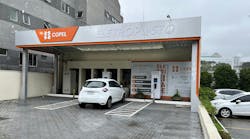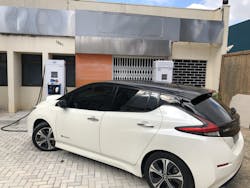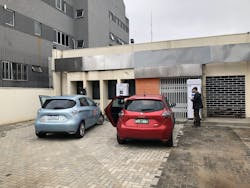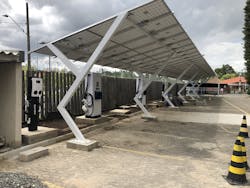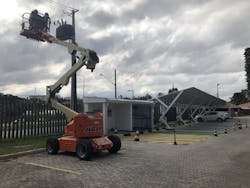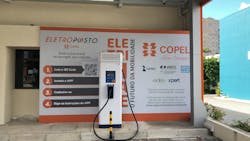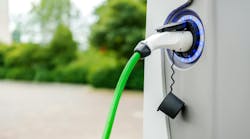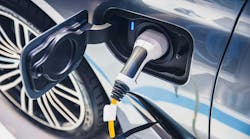Like many countries around the world, Brazil has seen a significant increase in the utilization of electric vehicles. During the pandemic, the country saw an increase of 80% in utilization per year. This growth has spurred the need for robust charging infrastructure, particularly in the cities.
According to the International Energy Agency (IEA), 860,000 public charging stations were installed in 2019 globally, and by the end of 2022, that number climbed to 2.7 million — an increase of 214%. Brazil is still in the early stages of rolling out its charging infrastructure. According to a 2021 report on Brazilian electric mobility from the National Electric Mobility Platform (PNME), it is estimated 150,000 charging stations will be needed by 2035 to meet a fleet of 3 million pure electric and plug-in hybrid vehicles. This represents a total investment of about US$2.5 billion to build the charging station infrastructure.
The infrastructure to charge electric vehicle (EV) batteries requires more energy, which can pose a risk during simultaneous charging. To address this problem, Brazil implemented an intelligent charging system. The system communicates with the charging stations, acquiring operational and technical information. Then an algorithm provides analyses of instantaneous power consumed by number of vehicles and — through a power limitation algorithm — controls the maximum energy level delivered to vehicles simultaneously, to avoid reaching peak power.
The solution has been implemented in two electrocenters in Curitiba, the capital city of Paraná. The project was carried out in partnership with Copel Distribuição, through the Brazilian Electricity Regulatory Agency (ANEEL) research and development program. Copel initiated the project as part of its initiative to implement the largest electric highway in Brazil.
Charging Station Control
EV charging stations have been developed with multiple communication systems (for example, LTE and Wi-Fi) and open charge point protocol (OCPP).
While numerous protocols exist, the most widely used is OCPP. This open-source protocol provides flexibility in the communication and management of charging stations. It is possible to monitor a variety of parameters and send commands, and even update programs such as firmware of the charging station.
OCPP is divided into sections. The so-called core is the main section and required for implementation. The other sections are more informative in nature but can serve as a management system.
Demand Management System
The main proposal for the development of this project was based on the use of the central system and communication protocol used by the charging station manufacturers (ChargePoint communication infrastructure was already in place). For this project, version 1.6 of the OCPP protocol was used.
Requirements for the central system were established, including minimum functionalities for integration with the management and billing platform:
- OCPP 1.6 protocol implementation for communication with charging stations through WebSocket interface
- Implementation of a database for recording configurations of charging stations and their owners, such as: model, charging capacity, type of plugs, number of plugs available, geographical location, owner identification, manufacturer, communication protocol and charger status
- Registration of new charging stations, which could have different brands and manufacturers as well as use different communication protocols
- Implementation of an algorithm to control load demand.
Electrocenter Locations
Sites were surveyed to determine where to place the electrocenter. In the end, the final decision was to divide it into two locations, one on the premises of Lactec, one of the largest research, technology and innovation centers in Brazil, and the other on the premises of Copel, both in Curitiba.
At the Copel site, access is free, whereas at Lactec, access is free during the week and has a fee on the weekends. They are both open to the public, so any user can access the site and charge their electric vehicle.
Electrical work was completed in accordance with Copel’s technical standards. For example, for the Lactec electrocenter, the electrical project included installing the electrical connections, loads (charging stations and accessory loads) and a photovoltaic system as a carport. At the Copel electrocenter, it is possible to observe the loads, with visibility to the charging stations and other accessory loads (lighting and telecommunications).
The Lactec electrocenter counts on a photovoltaic energy generation system that provides 30 kW of peak power and injects all the energy generated into Copel’s low-voltage grid (220 V to 380 V), where the EV charging stations are connected. By Brazilian legislation, the energy injected into the grid can be used as credits at this location and others belonging to Lactec (in this case, Lactec holds the responsibility for the energy bill of the Copel utility that feeds the charging stations).
Users can download an app (available in iOS and Android) to their mobile phone, register and carry out the charging process by releasing a plug for connection to their EV. This system was developed in a different project by Lactec, Copel, Eidee and Xpert, and it presents different charging values depending on the power available for vehicle charging.
The system developed for this project allows, at the same time, the operational management of the charging stations to control the maximum power available for each station, from the power demand contract. This system of demand control per charging station enables the maximum power of a set of stations not to exceed the maximum contracted with the distribution utility. A great advancement, this feature enables stations to be installed in an existing installation without the need to rewire the electrical system or redo the contract with the energy concessionary.
The demand limitation per charging station is dynamic, that is, the available power value changes during the day, allowing each EV to experience different power levels depending on the time of day and power consumption of the installation. The number of EVs filling up simultaneously can also affect this limit. Once it has set the power limit value for each station, the control system sends this limit using the set-charging-profile command within the OCPP.
Charging Stations
At Lactec, the electrocenter has six charging stations: four stations with two Mennekes T2 plugs at 22 kW each and two fast-charging stations with Mennekes T2, Chademo and CCS2 plugs (in this station, the alternating output has a maximum power of 43 kW and the CC charging outputs have a maximum power of 60 kW).
At Copel, the electrocenter has three stations: one alternating charging station (identical to Lactec’s, with 22-kW maximum power and two plugs), one fast-charging station (identical to Lactec’s, with three plugs — Mennekes T2, Chademo and CCS2) and one ultrafast-charging station (with 150-kW maximum power and a CCS2 plug).
Demand Control
According to the OCPP protocol, demand control has not yet been implemented in continuous charging systems, regardless of the power. The explanation is that different vehicles do not accept the command after charging has started. Therefore, the tests carried out in this project considered alternating charging stations with a maximum power of 22 kW. The continuous charging stations will be included in the demand control system only with regard to the availability, or lack thereof, of the station.
Depending on the charging station manufacturer, demand control is enabled by instantaneous power or electric current. In this project, the manufacturer enabled instantaneous electric current control.
Electrocenter Operation
The electrocenters became operational in December 2022, with users registering by the mobile app. Users are billed per minute of charging, and the amount depends on the maximum power each charging station can deliver to the vehicle.
The use of each charging station is simple: The user requests the release of the plug in the mobile app, connects the plug in the vehicle and, from there, the handshake is made between the station and vehicle, and the charge initiates. The user can select some charge parameters, but the most used, is the full charge. The user can interrupt the charge of the vehicle at any time, either in the app or by the vehicle.Demand control is active and operational, but as the number of EVs is still limited, no action has been taken at either of the electrocenters.
Since the start of operations, both electrocenters have supplied a total of 2.86 MWh. The average of each charge is 11.4 kWh.
A Complete Solution
The electrification process, which was initiated by Copel with an implementation project of the largest electric highway in Brazil, reached a new level with the rollout of the two electrocenters in the city of Curitiba. Users now have access to numerous charging stations with different power capacities and can charge EVs simultaneously. The period of operation is short yet most users prefer the higher 150-kW equipment, even though this power is not achievable with most EVs operating in Brazil today.
Finally, the junction with another project that developed the mobile and billing system, associated with demand control, offers users a complete solution for charging EVs with operational reliability and high-power availability. Brazil expects the user base will expand in terms of power delivered for charging.
Acknowledgment
The authors would like to thank Copel Distribuição for its funding through the ANEEL research and development program resources (code number 2866-0517-2019).
Carlos Gabriel Bianchin ([email protected]) has BSEE and MSEE degrees as wel as a D Sc degree in 2017 in power converter for recharge electric vehicles and is a researcher at LACTEC, the Institute of Technology for Development. His responsibilities include static converters, electrical power distribution, digital control by digital signal processors, power quality, power factor, rectifiers and battery charging for EVs.
Ricardo Muzzolon Schmal ([email protected]) has a degree in computer engineering and a post-graduate degree in biomedical engineering. Employed at LACTEC, he has worked on metering systems, phase identification and the construction of an underground chamber for training teams. Currently, Schmal is engaged in the development of charging systems for EVs.
Rafael Moreira Miggiorin ([email protected]) is an electrical engineer experienced in software and firmware development for embedded applications. Currently a system development engineer with Siemens.
Rhafael Freitas da Costa ([email protected]) graduated in Information Systems from the State University of Northern Paraná - UENP/CLM. Postgraduate, specialization level in Database from the University of Northern Paraná - UNOPAR. Professional master’s degree in technology development from the research institute for development. He currently works at LACTEC as a Software development specialist.
Lucio de Medeiros ([email protected]) is a senior researcher at LACTEC. He has more than 25 years of experience in energy efficiency, statistics modeling, and forecasting methods applied to the energy sector. He is also a senior researcher at LACTEC Instituto de Tecnologia para o Desenvolvimento. He has previously worked at ICF International as senior energy manager, and at ENEL Rio de Janeiro as an energy market and regulation specialist.
Rodrigo Braun dos Santos ([email protected]) is project manager in smart grid and special projects division with Copel Distribuição, Curitiba, Brazil.
